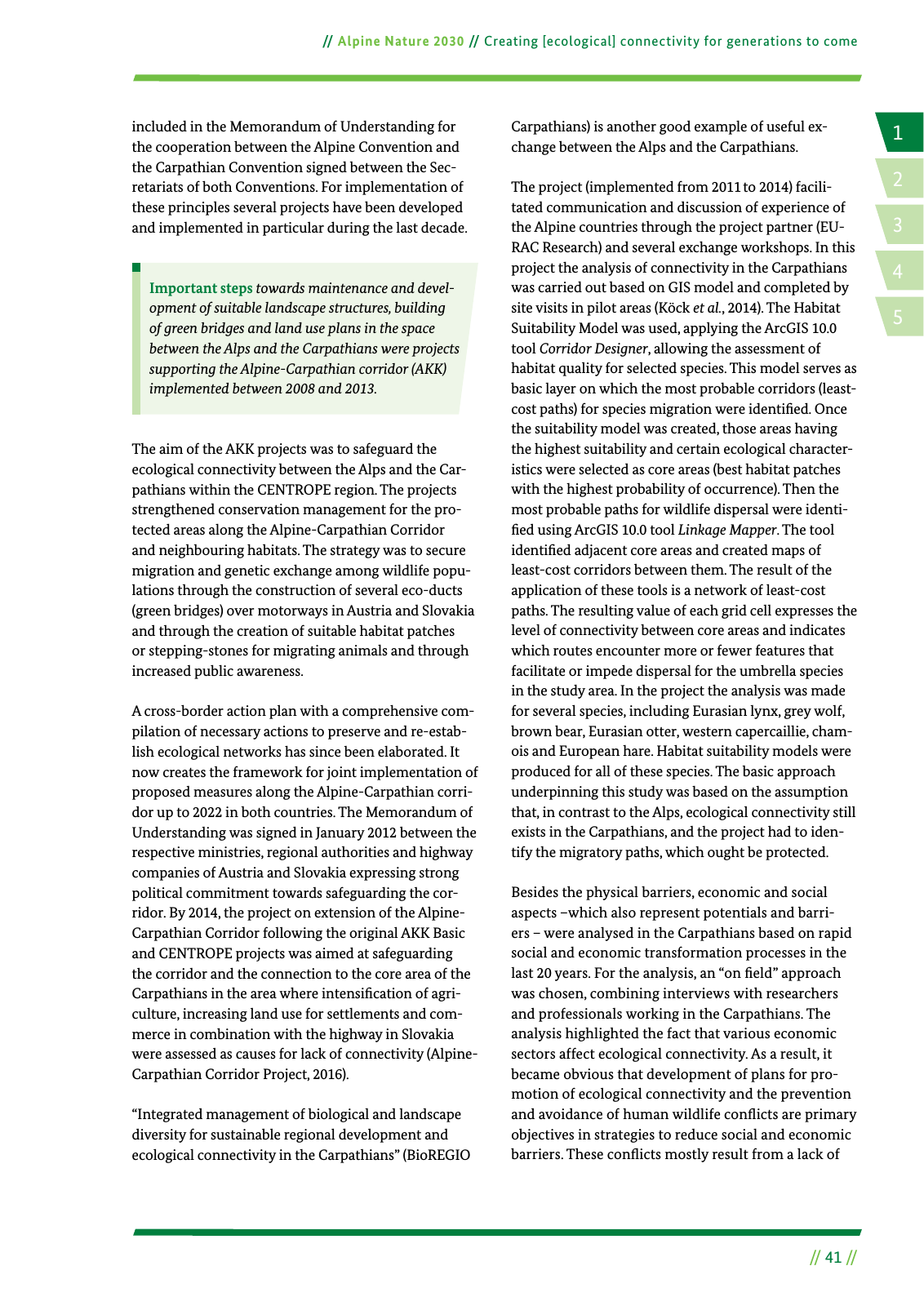14 2 5 3 41 Alpine Nature 2030 Creating ecological connectivity for generations to come included in the Memorandum of Understanding for the cooperation between the Alpine Convention and the Carpathian Convention signed between the Sec retariats of both Conventions For implementation of these principles several projects have been developed and implemented in particular during the last decade Important steps towards maintenance and devel opment of suitable landscape structures building of green bridges and land use plans in the space between the Alps and the Carpathians were projects supporting the Alpine Carpathian corridor AKK implemented between 2008 and 2013 The aim of the AKK projects was to safeguard the ecological connectivity between the Alps and the Car pathians within the CENTROPE region The projects strengthened conservation management for the pro tected areas along the Alpine Carpathian Corridor and neighbouring habitats The strategy was to secure migration and genetic exchange among wildlife popu lations through the construction of several eco ducts green bridges over motorways in Austria and Slovakia and through the creation of suitable habitat patches or stepping stones for migrating animals and through increased public awareness A cross border action plan with a comprehensive com pilation of necessary actions to preserve and re estab lish ecological networks has since been elaborated It now creates the framework for joint implementation of proposed measures along the Alpine Carpathian corri dor up to 2022 in both countries The Memorandum of Understanding was signed in January 2012 between the respective ministries regional authorities and highway companies of Austria and Slovakia expressing strong political commitment towards safeguarding the cor ridor By 2014 the project on extension of the Alpine Carpathian Corridor following the original AKK Basic and CENTROPE projects was aimed at safeguarding the corridor and the connection to the core area of the Carpathians in the area where intensi cation of agri culture increasing land use for settlements and com merce in combination with the highway in Slovakia were assessed as causes for lack of connectivity Alpine Carpathian Corridor Project 2016 Integrated management of biological and landscape diversity for sustainable regional development and ecological connectivity in the Carpathians BioREGIO Carpathians is another good example of useful ex change between the Alps and the Carpathians The project implemented from 2011 to 2014 facili tated communication and discussion of experience of the Alpine countries through the project partner EU RAC Research and several exchange workshops In this project the analysis of connectivity in the Carpathians was carried out based on GIS model and completed by site visits in pilot areas Köck et al 2014 The Habitat Suitability Model was used applying the ArcGIS 10 0 tool Corridor Designer allowing the assessment of habitat quality for selected species This model serves as basic layer on which the most probable corridors least cost paths for species migration were identi ed Once the suitability model was created those areas having the highest suitability and certain ecological character istics were selected as core areas best habitat patches with the highest probability of occurrence Then the most probable paths for wildlife dispersal were identi ed using ArcGIS 10 0 tool Linkage Mapper The tool identi ed adjacent core areas and created maps of least cost corridors between them The result of the application of these tools is a network of least cost paths The resulting value of each grid cell expresses the level of connectivity between core areas and indicates which routes encounter more or fewer features that facilitate or impede dispersal for the umbrella species in the study area In the project the analysis was made for several species including Eurasian lynx grey wolf brown bear Eurasian otter western capercaillie cham ois and European hare Habitat suitability models were produced for all of these species The basic approach underpinning this study was based on the assumption that in contrast to the Alps ecological connectivity still exists in the Carpathians and the project had to iden tify the migratory paths which ought be protected Besides the physical barriers economic and social aspects which also represent potentials and barri ers were analysed in the Carpathians based on rapid social and economic transformation processes in the last 20 years For the analysis an on eld approach was chosen combining interviews with researchers and professionals working in the Carpathians The analysis highlighted the fact that various economic sectors affect ecological connectivity As a result it be came obvious that development of plans for pro motion of ecological connectivity and the prevention and avoidance of human wildlife con icts are primary objectives in strategies to reduce social and economic barriers These con icts mostly result from a lack of

Hinweis: Dies ist eine maschinenlesbare No-Flash Ansicht.
Klicken Sie hier um zur Online-Version zu gelangen.
Klicken Sie hier um zur Online-Version zu gelangen.